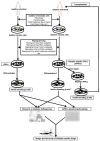Recent Advances in Disease Modeling and Drug Discovery for Diabetes Mellitus Using Induced Pluripotent Stem Cells
- PMID: 26907255
- PMCID: PMC4783985
- DOI: 10.3390/ijms17020256
Recent Advances in Disease Modeling and Drug Discovery for Diabetes Mellitus Using Induced Pluripotent Stem Cells
Abstract
Diabetes mellitus (DM) is a widespread metabolic disease with a progressive incidence of morbidity and mortality worldwide. Despite extensive research, treatment options for diabetic patients remains limited. Although significant challenges remain, induced pluripotent stem cells (iPSCs) have the capacity to differentiate into any cell type, including insulin-secreting pancreatic β cells, highlighting its potential as a treatment option for DM. Several iPSC lines have recently been derived from both diabetic and healthy donors. Using different reprogramming techniques, iPSCs were differentiated into insulin-secreting pancreatic βcells. Furthermore, diabetes patient-derived iPSCs (DiPSCs) are increasingly being used as a platform to perform cell-based drug screening in order to develop DiPSC-based cell therapies against DM. Toxicity and teratogenicity assays based on iPSC-derived cells can also provide additional information on safety before advancing drugs to clinical trials. In this review, we summarize recent advances in the development of techniques for differentiation of iPSCs or DiPSCs into insulin-secreting pancreatic β cells, their applications in drug screening, and their role in complementing and replacing animal testing in clinical use. Advances in iPSC technologies will provide new knowledge needed to develop patient-specific iPSC-based diabetic therapies.
Keywords: cell-based drug screening; diabetes mellitus; iPSC-based diabetic therapy; induced pluripotent stem cells; insulin-secreting β cells.
Figures


Similar articles
-
Advances in the Generation of Functional β-cells from Induced Pluripotent Stem Cells As a Cure for Diabetes Mellitus.Curr Drug Targets. 2018;19(13):1463-1477. doi: 10.2174/1389450119666180605112917. Curr Drug Targets. 2018. PMID: 29874998 Review.
-
Recent Advances in the Generation of β-Cells from Induced Pluripotent Stem Cells as a Potential Cure for Diabetes Mellitus.Adv Exp Med Biol. 2021;1347:1-27. doi: 10.1007/5584_2021_653. Adv Exp Med Biol. 2021. PMID: 34426962 Review.
-
Differentiation of human pluripotent stem cells into β-cells: Potential and challenges.Best Pract Res Clin Endocrinol Metab. 2015 Dec;29(6):833-47. doi: 10.1016/j.beem.2015.10.011. Epub 2015 Oct 30. Best Pract Res Clin Endocrinol Metab. 2015. PMID: 26696513 Review.
-
Tumor-Free Transplantation of Patient-Derived Induced Pluripotent Stem Cell Progeny for Customized Islet Regeneration.Stem Cells Transl Med. 2016 May;5(5):694-702. doi: 10.5966/sctm.2015-0017. Epub 2016 Mar 17. Stem Cells Transl Med. 2016. PMID: 26987352 Free PMC article.
-
From stem cells to pancreatic β-cells: strategies, applications, and potential treatments for diabetes.Mol Cell Biochem. 2025 Jan;480(1):173-190. doi: 10.1007/s11010-024-04999-x. Epub 2024 Apr 20. Mol Cell Biochem. 2025. PMID: 38642274 Review.
Cited by
-
Hypoglycemic Effects of Plant Flavonoids: A Review.Evid Based Complement Alternat Med. 2021 Dec 8;2021:2057333. doi: 10.1155/2021/2057333. eCollection 2021. Evid Based Complement Alternat Med. 2021. PMID: 34925525 Free PMC article. Review.
-
Therapeutic potential of stem cells from human exfoliated deciduous teeth infusion into patients with type 2 diabetes depends on basal lipid levels and islet function.Stem Cells Transl Med. 2021 Jul;10(7):956-967. doi: 10.1002/sctm.20-0303. Epub 2021 Mar 4. Stem Cells Transl Med. 2021. PMID: 33660433 Free PMC article.
-
Challenges with Cell-based Therapies for Type 1 Diabetes Mellitus.Stem Cell Rev Rep. 2023 Apr;19(3):601-624. doi: 10.1007/s12015-022-10482-1. Epub 2022 Nov 25. Stem Cell Rev Rep. 2023. PMID: 36434300 Review.
-
May I Cut in? Gene Editing Approaches in Human Induced Pluripotent Stem Cells.Cells. 2017 Feb 6;6(1):5. doi: 10.3390/cells6010005. Cells. 2017. PMID: 28178187 Free PMC article. Review.
-
Elongation of Axon Extension for Human iPSC-Derived Retinal Ganglion Cells by a Nano-Imprinted Scaffold.Int J Mol Sci. 2017 Sep 20;18(9):2013. doi: 10.3390/ijms18092013. Int J Mol Sci. 2017. PMID: 28930148 Free PMC article.
References
-
- Defronzo R.A. Pathogenesis of type 2 diabetes: Metabolic and molecular implications for identifying diabetes genes. Diabetes Rev. 1997;5:177–269. doi: 10.2165/00003495-199958001-00008. - DOI
Publication types
MeSH terms
Substances
LinkOut - more resources
Full Text Sources
Other Literature Sources
Medical

